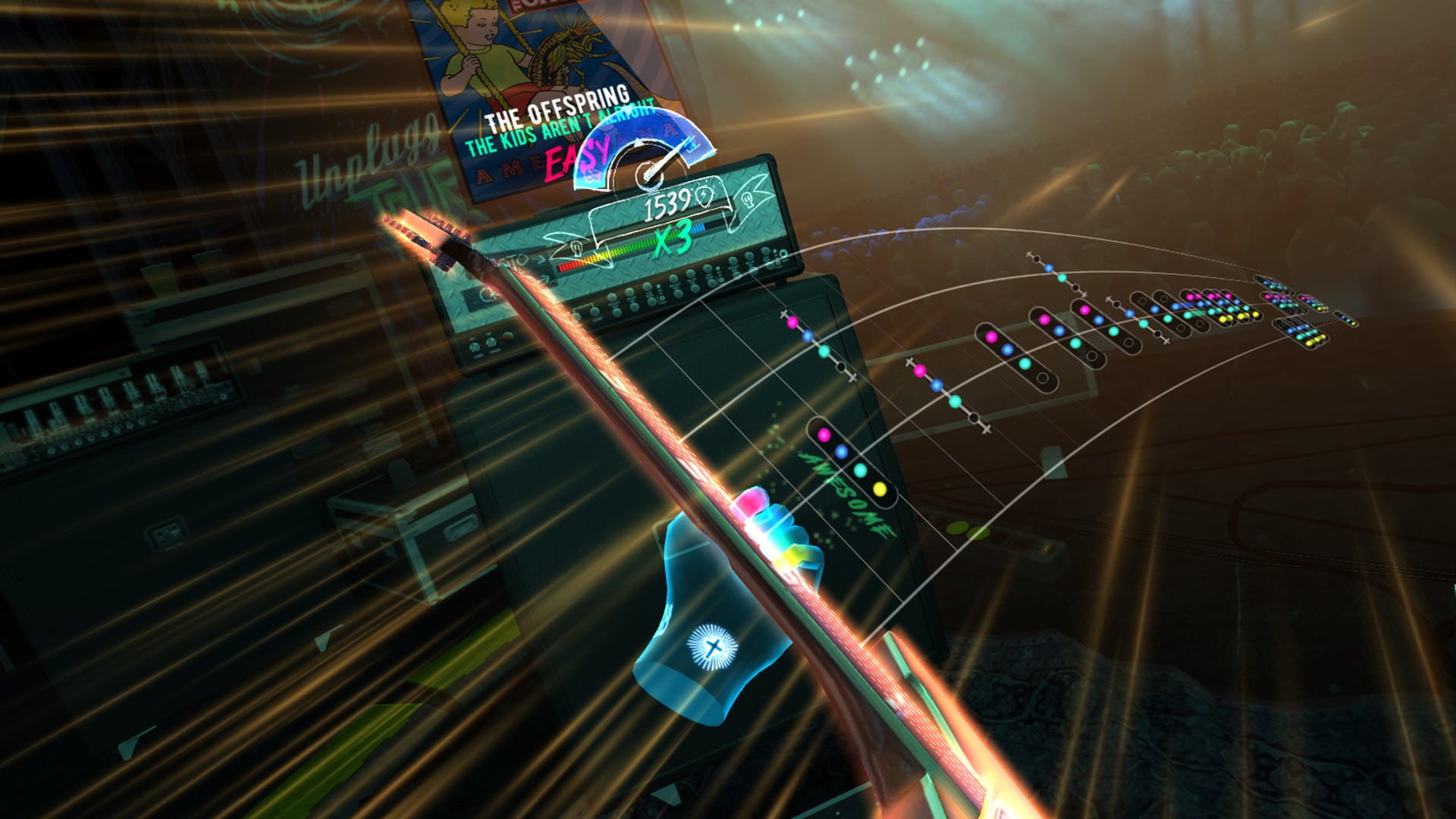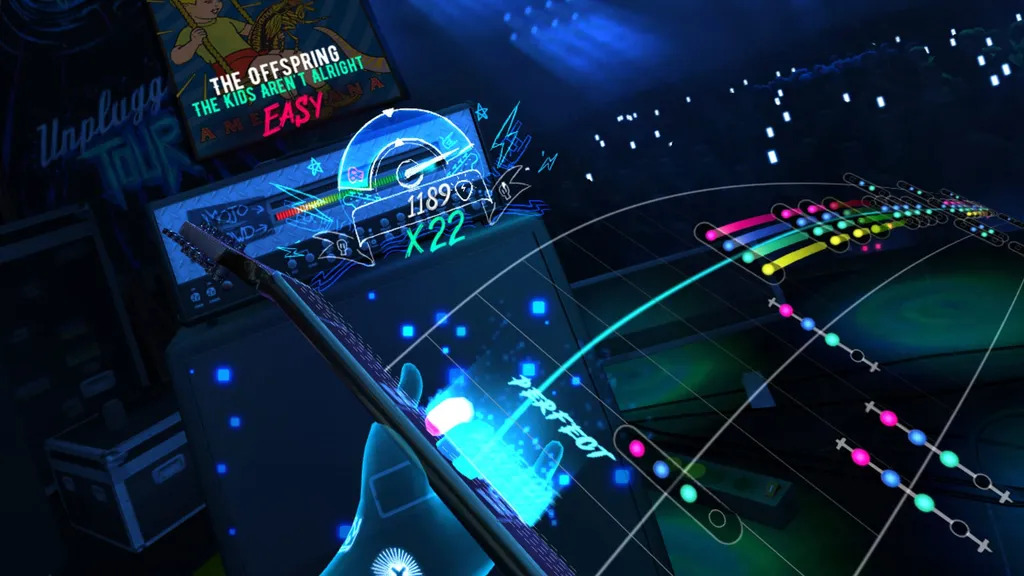With support for Meta’s Hand Tracking 2.0 update, Unplugged is more responsive than ever, surpassing every other hand tracking game on Quest. Here’s our updated Unplugged review.
Note: This review was originally published on release in October 2021. In May 2022, we updated the review to reflect the recent changes in technology and gameplay since launch, including a section below addressing the improvements specifically.
Unplugged is essentially VR’s spiritual successor to classic rock games like Guitar Hero and Rock Band.
But gone are the days of bulky, plastic peripherals; you only need your hands to play Unplugged. This lets the genre move towards something more immersive and thrilling, keeping the same spirit of those classic titles while also doing something completely different and new.
But before getting into further detail, let’s get one thing straight about Unplugged: the feeling of using your hands to act out air guitar moves is a completely unmatched experience and technical accomplishment on Quest 2. No other hand tracking experience comes even remotely close in terms of sheer thrill and innovation.
[vc_row][vc_column][vc_cta h2=””]Unplugged Review – The Facts
What is it?: A VR rhythm game in which you use hand tracking to air guitar your way to stardom.
Platforms: Meta Quest, Meta Quest 2 with hand tracking, PC VR using Index controllers (read more here)
Release Date: October 21
Price: $24.99[/vc_cta][/vc_column][/vc_row][vc_row][vc_column][vc_column_text]
This isn’t a one-to-one simulation of real guitar, but instead it embarks on a fantasy-fulfilling journey to make you feel like a true rockstar, shredding through air and playing to a pumping crowd. In its best moment, it feels absolutely unparalleled.
Rocking Out With A Killer Setlist
While the experience is wholly unique, Unplugged’s core gameplay loop is fairly simple — make chord shapes with the fingers in your left hand, strum in time with your right. The more consecutive notes you land, the bigger combo you’ll build and the higher you’ll score. Think Guitar Hero crossed with Tap Tap Revenge and Beat Saber.
The track mappings may not be quite as complex or technical as rock games like Guitar Hero or Rock Band just yet, but they do push Quest’s hand tracking technology much further than you would expect.
While Unplugged was still a fantastic experience at launch, it was also nonetheless slightly limited by the Quest’s hand tracking capabilities at the time. However, recent leaps in technology with Hand Tracking 2.0 have significantly improved the experience on Quest 2. There’s still the occasional hiccup, but fast movements and strumming are more dependable than ever.
This has also allowed Anotherway to go back and re-map the entire collection of tracks, adding increased nuance, complexity and notes. This increased challenge also brings with it a higher skill ceiling, and Quest 2’s hand tracking is able to keep up with a degree of speed, reliability and accuracy that we’ve never seen before.
There’s a solid tracklist of well-known rock songs to work through, especially for a debut rhythm game. You’ll recognize tracks like Say It Ain’t So by Weezer, Bohemian Like You by The Dandy Warhols or Should I Stay Or Should I Go by The Clash, just to name a few. Even the lesser known tracks have clearly been picked with care — each one feels distinct and offers a slightly different style of mapping, matching the feel of the songs themselves.
A free and exclusive Steel Panther song was also added post launch, as well as a $4.99 DLC pack containing tracks from Muse, Slayer and more.
Songs are divided into groups, or ‘records’, which roughly ascend in difficulty and complexity. All songs are unlocked from the start with three difficulty levels each – Easy, Normal, Hard. Each record has three associated challenges – completing those will help you unlock bigger venues to play in, starting in a small bar and working up to an arena. There’s also passthrough support, which lets you to play in a stylized version of your real surroundings.
Learning the Ropes
Unplugged isn’t an easy game – there’s lots of challenge to be had, especially on the higher difficulties. The novelty of the concept means there’s a bit of a learning curve to work through as well. Luckily, the state of the game post-launch makes that smoother than ever for beginners.
It’s also essential to give the game the best possible conditions for optimal hand tracking. As you’ll be told in the tutorial, led by Steel Panther’s Satchel, roll up your sleeves, play in a well lit area with high contrast between your hands and the background, and wipe the headset’s camera lenses before playing.
Follow those rules and you’ll find the hand tracking to be extremely reliable and responsive. It’s now rare to encounter significant tracking errors while playing, which means it’s much easier to tell how and why you’re at fault when you make mistakes mid-track.
Once the initial acclimitization is over, you’ll quickly start to improve and feel more and more like a rock god. Anotherway is aware that some finger shapes and chord changes are harder to nail than others, so Unplugged’s collection of tracks is cultivated to smartly adapt the mapping across the records, easing players into the action and gradually turning up the complexity.
The first few records focus on simpler shapes and use just a few fingers at a time, sticking to very straight, on-beat rhythms. As you get into the latter records, the mapping becomes more melodic, finger shapes more complex and chord changes more frequent, with less straightforward rhythms. When you miss a note or play something incorrectly, the game will play a cracked guitar tone and cut the audio for corresponding section you missed – a very welcome change added post-launch change.
There are also slide notes, which don’t require any strumming, and vibrato sustained notes that grant extra points for shaking your fingers up and down the fret. Solos are the highlights of each map, which tend to focus on slide and vibrato notes as well as special shredding sequences that let you go wild with ad-libbed, mindless air shredding. It’s an unbelievably satisfying feeling when you manage to nail every note in a solo perfectly.
The mapping doesn’t exclusively replicate the guitar lines of each track either. In sequences where guitars are minimal or missing from a track, you’ll play notes representing other instruments as well, such as vocals of bass.
There’s a sense of manageable challenge across all the tracks – as you become more acquainted with each, you’ll probably find yourself replaying favourites over and over just to get a higher score. In short, it’s disgustingly addictive.
Pressure Points
Even with the recent hand tracking improvements, there remain just a few caveats to keep in mind. There is still a tiny – but sometimes noticeable – amount of latency between your hands’ actions and them being registered in-game. It’s an issue inherent with the technology, not the game itself, but it can nonetheless mess with your timing on complex sequences here and there. Focusing on the beat of the music itself – and looking slightly ahead of the fret – lessens the latency’s impact.

Likewise, there remain a few transitions that feel a little too quick and difficult to land reliably, especially on Hard. Moving from one position on the fret to another while also changing chords seems to be a pressure point and one of the only remaining areas where hand tracking can feel ever so slightly inadequate.
Tracking aside, Unplugged doesn’t always do the best job of accurately representing its more complex rhythmic sequences. Visually, the gaps between notes and chords often look equally spaced, even when the actual rhythm the game expects you to play is not. This can make it hard to interpret fast and irregular sections, especially if you’re not already familiar with the song. Trial and error will often clear this up, but it’s an area for improvement nonetheless.
Mini Games, Modes, Modifiers
Higher difficulties also introduce some mid-track mini games, such as ‘cursed’ flaming notes that have to be hit perfectly. Missing a flaming note will send a string out of tune – time slows down and a guitar neck will appear floating in front you, prompting you to quickly re-tune before you can resume playing. It’s an interesting idea, but feels more tedious and distracting in practice.
You can also boost your score by hitting combo cubes with your guitar neck as they appear mid-song. Advanced players might be able to hit these with dramatic rockstar swings, but I found it difficult to pull off without introducing tracking problems or missing notes.
You can also amp up the audience after a good run by the horns and catching undergarments thrown from the crowd. This gives you points to spend on cosmetic guitar models to use in-game, but the selection a bit underwhelming. The biggest and most iconic brands like Fender and Les Paul are missing – perhaps understandably, given how new the franchise is.
Unlike many other rhythm games, there’s also no modifiers or alternate modes just yet, which feels like a missed opportunity. Giving players more options to play the way they want, like you can do in Beat Saber or Pistol Whip, would be a fantastic addition.
Post-Launch Improvements with Hand Tracking 2.0
The difference between Unplugged at launch and now is close to night-and-day – and that’s saying something, given the baseline was already very impressive. Everything has been improved and the experience is better now than I ever thought it would be on Quest 2.
Previously, some sessions with Unplugged used to feel like you were wrestling with the hand tracking just to find the perfect conditions for the game to operate in. Now, it’s much less fussy and infinitely more reliable in a wider range of settings. Optimal conditions remain important, but you’ll spend significantly less time adjusting everything and more time rocking out. The aforementioned quick transitions are the only area that remain an occasional hang-up, but that’s forgivable given the huge leaps elsewhere.
Other smaller changes – unlocking all songs from the start, cutting out audio when notes are missed, re-mapping tracks to account for Hand Tracking 2.0 – are more than welcome and push the experience closer to in style to classics like Guitar Hero and Rock Band.
Unplugged Review – Final Verdict
Unplugged feels like the first app to take Quest’s hand tracking to a new conceptual and technical level, using the technology to breathe life into the imaginary and fulfil a fantasy of every rock fan.
At launch, the concept felt just slightly ahead of the technology, perhaps a few years behind developments that could take it to the next level. But only seven months later, it’s shocking how quickly Meta’s software has caught up and improved the experience from all angles. The baseline was already strong, but the game is now more accurate and responsive than ever.
Though there’s still room for improvement, Anotherway and Vertigo Games have landed on a concept that is addicting and completely unique. There’s really nothing else quite like Unplugged on the Quest platform – or any VR platform, for that matter. It’s a shining example of how VR and AR technology can offer totally unique experiences, previously thought unimaginable.
It sounds too good to be true, but it’s not. For that reason alone, every Quest owner should give Unplugged a try.

UploadVR recently changed its review guidelines, and this is one of our new Essential review labels. You can read more about our review guidelines here.
This review was conducted on the Quest 2 version of the game – you can read our seperate impressions of the PC VR version for Index here. What did you make of our Unplugged review? Let us know in the comments below!
























